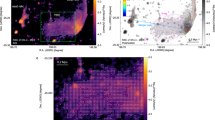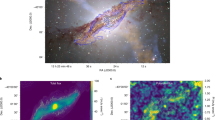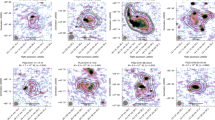Abstract
The motion of our Galaxy through the Universe is reflected in a systematic shift in the temperature of the cosmic microwave background1—because of the Doppler effect, the temperature of the background is about 0.1 per cent higher in the direction of motion, with a correspondingly lower temperature in the opposite direction. This effect is known as dipole anisotropy. If our standard cosmological model is correct, a related dipole effect should also be present as an enhancement in the surface density of distant galaxies in the direction of motion2. The main obstacle to finding this signal is the uneven distribution of galaxies in the local supercluster, which drowns out the small cosmological signal. Here we report a detection of the expected cosmological dipole anisotropy in the distribution of galaxies. We use a survey of radio galaxies that are mainly located at cosmological distances, so the contamination from nearby clusters is small. When local radio galaxies are removed from the sample, the resulting dipole is in the same direction as the temperature anisotropy of the microwave background, and close to the expected amplitude. The result therefore confirms the standard cosmological interpretation of the microwave background.
This is a preview of subscription content, access via your institution
Access options
Subscribe to this journal
Receive 51 print issues and online access
$199.00 per year
only $3.90 per issue
Buy this article
- Purchase on Springer Link
- Instant access to full article PDF
Prices may be subject to local taxes which are calculated during checkout




Similar content being viewed by others
References
Smoot, G., Gorenstein, M. & Muller, R. Detection of anisotropy in the cosmic black-body radiation. Phys. Rev. Lett. 39, 898–901 (1977).
Ellis, G. & Baldwin, J. On the expected anisotropy of radio source counts. Mon. Not. R. Astron. Soc. 206, 377–381 (1984).
Scharf, C. et al. The 2–10 keV X-ray background dipole and its cosmological implications. Astrophys. J. 544, 49–62 (2000).
Baleisis, A., Lahav, O., Loan, A. J. & Wall, J. V. Searching for large-scale structure in deep radio surveys. Mon. Not. R. Astron. Soc. 297, 545–558 (1998).
Lahav, O. Optical dipole anisotropy. Mon. Not. R. Astron. Soc. 225, 213–220 (1987).
Rowan-Robinson, M. et al. The IRAS PSCz dipole. Mon. Not. R. Astron. Soc. 314, 375–397 (2000).
Condon, J. J. The NRAO VLA Sky Survey. Astron. J. 115, 1693–1716 (1998).
Dunlop, J. S. & Peacock, J. A. The redshift cut-off in the luminosity function of radio galaxies and quasars. Mon. Not. R. Astron. Soc. 247, 19–42 (1990).
Saunders, W. et al. The PSCz catalogue. Mon. Not. R. Astron. Soc. 317, 55–64 (2000).
Corwin, H., Buta, R. & de Vacouleurs, G. Corrections and additions to the third reference catalogue of bright galaxies. Astron. J. 108, 2128–2144 (1994).
Lineweaver, C. in Proc. XVIth Moriond Astrophysics Meeting 69–75 (Editions Frontieres, Gif-sur-Yvette, 1997).
Acknowledgements
We thank L. Miller and S. Rawlings for comments on early drafts. We also thank J. Condon for comments and suggestions.
Author information
Authors and Affiliations
Corresponding author
Ethics declarations
Competing interests
The authors declare no competing financial interests.
Rights and permissions
About this article
Cite this article
Blake, C., Wall, J. A velocity dipole in the distribution of radio galaxies. Nature 416, 150–152 (2002). https://doi.org/10.1038/416150a
Received:
Accepted:
Issue Date:
DOI: https://doi.org/10.1038/416150a
This article is cited by
-
Probing cosmology beyond \(\Lambda \)CDM using SKA
Journal of Astrophysics and Astronomy (2023)
-
Extragalactic radio continuum surveys and the transformation of radio astronomy
Nature Astronomy (2017)
-
Probing Statistical Isotropy of Cosmological Radio Sources using Square Kilometre Array
Journal of Astrophysics and Astronomy (2016)
-
Science with ASKAP
Experimental Astronomy (2008)
-
Maintaining the standard
Nature (2002)
Comments
By submitting a comment you agree to abide by our Terms and Community Guidelines. If you find something abusive or that does not comply with our terms or guidelines please flag it as inappropriate.



